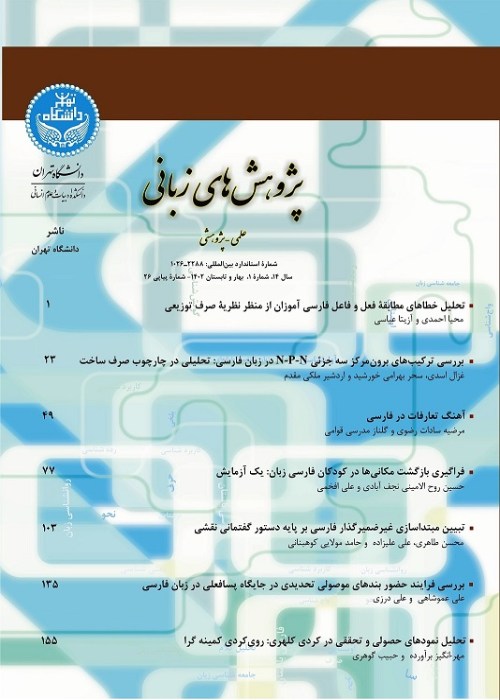Derivational Prefixes Ordering
Author(s):
Article Type:
Research/Original Article (دارای رتبه معتبر)
Abstract:
Affix ordering is a theoretical discussion in morphology. There has been some debate over the existence of general principles or mechanisms governing affix ordering. In this regard, we can point to three principal approaches. The first approach named the stratum-oriented model (Siegel, 1974; Allen, 1978; Kiparsky, 1982; Mohanan, 1986), believes that lexicon has a layered structure and can determine the affixes' combinations. The second approach relies on Selectional Restrictions' affix oriented (Fabb, 1988; Plag, 1999). These restrictions include restrictions of the group of affixes and phonological, morphological, semantic, and syntax restrictions. This approach claims that the description of possible and impossible combinations of affixes is related to describing the functions of restrictions. The third approach formed the theoretical framework of the present study by providing a psycho-linguistic model based on this idea that the affix ordering is a function of the degree of parsability of affixes from their bases (Hay 2000; 2002). According to this approach, affixes parsed easily in language processing cannot stay near the base relative to the affixes with a lower degree of parsability. Plag (2003) called the approach as Complexity-Based Ordering (CBO). The question is that how can we describe the Persian derivational prefixes ordering based on the CBO framework. For this reason, by selecting 17 prefixes 2200 derivational words extracted from database. By considering prefixes co-occurrences the rank of each prefix was obtained by using directed-graph and upper triangle square matrixes. According to this theoretical framework, by using frequency of derivational words and bases we could draw the scatter plot and determined the rank of type and token frequency ratio. Finally, according to data and by using the rank of parsability, type and token frequency ratio, we assessed the continuum of Persian prefixes ordering. Similar to Hay and Plag (2004) findings, this approach can describe Persian prefixes ordering as well as English affixes ordering
Keywords:
Language:
Persian
Published:
Language Research, Volume:12 Issue: 1, 2021
Pages:
71 to 96
magiran.com/p2326547
دانلود و مطالعه متن این مقاله با یکی از روشهای زیر امکان پذیر است:
اشتراک شخصی
با عضویت و پرداخت آنلاین حق اشتراک یکساله به مبلغ 1,390,000ريال میتوانید 70 عنوان مطلب دانلود کنید!
اشتراک سازمانی
به کتابخانه دانشگاه یا محل کار خود پیشنهاد کنید تا اشتراک سازمانی این پایگاه را برای دسترسی نامحدود همه کاربران به متن مطالب تهیه نمایند!
توجه!
- حق عضویت دریافتی صرف حمایت از نشریات عضو و نگهداری، تکمیل و توسعه مگیران میشود.
- پرداخت حق اشتراک و دانلود مقالات اجازه بازنشر آن در سایر رسانههای چاپی و دیجیتال را به کاربر نمیدهد.
In order to view content subscription is required
Personal subscription
Subscribe magiran.com for 70 € euros via PayPal and download 70 articles during a year.
Organization subscription
Please contact us to subscribe your university or library for unlimited access!


